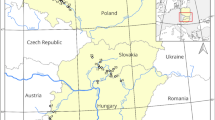Abstract
IN a wood covering several acres on the Lower Greensand of Surrey, Mercurialis perennis (dog's mercury) appeared to be distributed in an irregular way, in patches which clearly were not determined by the light intensity alone. In one case it was abundant along the lower side and absent along the upper side of a track that ran across a gentle slope. The pathway had been made up with chalk, and it was clear that the sandy soil below the path had become a possible habitat for Mercurialis because of the washing down of solid calcium carbonate and probably of dissolved bicarbonate as well. The whole region covered by the wood bears scattered patches of chalky soil, owing to transport of chalk for agricultural use and in making up trackways.
This is a preview of subscription content, access via your institution
Access options
Subscribe to this journal
Receive 51 print issues and online access
$199.00 per year
only $3.90 per issue
Buy this article
- Purchase on Springer Link
- Instant access to full article PDF
Prices may be subject to local taxes which are calculated during checkout
Similar content being viewed by others
References
De Silva, B. L. T., J. Ecol., 22, 532 (1934).
Mukerji, S. K., J. Ecol., 24, 317 (1936).
Author information
Authors and Affiliations
Rights and permissions
About this article
Cite this article
SIMPSON, J. Precise Distribution of Mercurialis perennis according to Soil Hydrogen Ion Concentration. Nature 139, 632–633 (1937). https://doi.org/10.1038/139632a0
Issue Date:
DOI: https://doi.org/10.1038/139632a0
Comments
By submitting a comment you agree to abide by our Terms and Community Guidelines. If you find something abusive or that does not comply with our terms or guidelines please flag it as inappropriate.



